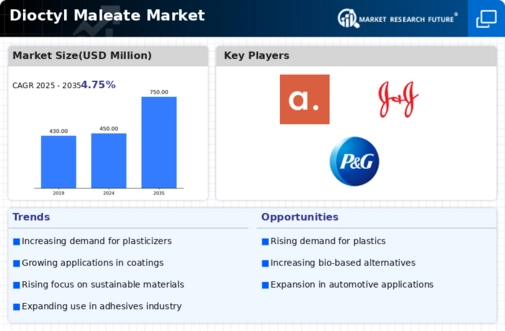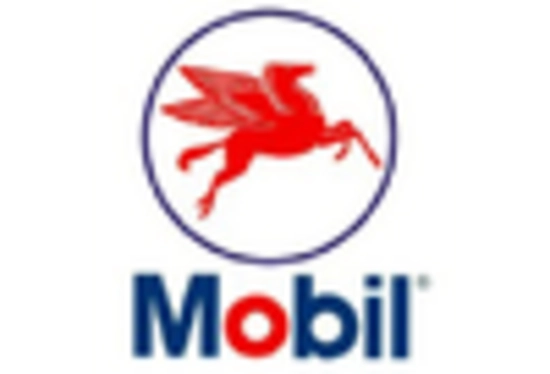Rising Demand in Plasticizers
The Dioctyl Maleate Market is experiencing a notable increase in demand for plasticizers, particularly in the production of flexible PVC products. As industries seek to enhance the performance characteristics of their materials, dioctyl maleate serves as an effective plasticizer that improves flexibility and durability. Recent data indicates that the plasticizer segment is projected to grow at a compound annual growth rate of approximately 4.5% over the next five years. This growth is driven by the expanding construction and automotive sectors, where high-performance materials are essential. Consequently, the rising demand for plasticizers in these industries is likely to bolster the Dioctyl Maleate Market, as manufacturers increasingly turn to dioctyl maleate to meet evolving performance standards.
Expanding Applications in Coatings
The Dioctyl Maleate Market is witnessing an expansion in applications within the coatings sector. Dioctyl maleate is utilized as a reactive diluent in various coating formulations, enhancing properties such as adhesion, flexibility, and chemical resistance. The coatings market is anticipated to grow significantly, with a projected increase of around 5% annually. This growth is attributed to the rising demand for high-performance coatings in automotive, industrial, and architectural applications. As manufacturers seek to develop more efficient and durable coatings, the incorporation of dioctyl maleate is likely to become more prevalent, thereby driving the Dioctyl Maleate Market forward.
Regulatory Support for Chemical Safety
The Dioctyl Maleate Market is positively impacted by regulatory support aimed at enhancing chemical safety. Governments and regulatory agencies are increasingly implementing stringent guidelines to ensure the safe use of chemicals in various applications. Dioctyl maleate, recognized for its favorable safety profile, is likely to benefit from these regulations, as manufacturers seek compliant materials for their products. The emphasis on safety and compliance is expected to drive demand for dioctyl maleate, particularly in industries such as food packaging and consumer goods. This regulatory environment may foster growth within the Dioctyl Maleate Market, as companies prioritize the use of safer alternatives.
Technological Innovations in Production
The Dioctyl Maleate Market is being shaped by ongoing technological innovations in production processes. Advances in chemical synthesis and processing techniques are enhancing the efficiency and cost-effectiveness of dioctyl maleate production. These innovations not only reduce production costs but also improve the quality and consistency of the final product. As a result, manufacturers are better positioned to meet the increasing demand for dioctyl maleate across various applications. The potential for improved production methods may lead to a more competitive landscape within the Dioctyl Maleate Market, as companies strive to leverage these advancements to capture market share.
Increased Focus on Eco-Friendly Products
The Dioctyl Maleate Market is influenced by a growing emphasis on eco-friendly and sustainable products. As consumers and regulatory bodies increasingly prioritize environmental considerations, manufacturers are compelled to adopt greener alternatives in their formulations. Dioctyl maleate, being a non-toxic and biodegradable option, aligns well with these sustainability goals. The market for eco-friendly plasticizers is expected to expand, with projections indicating a growth rate of approximately 6% over the next few years. This trend suggests that the Dioctyl Maleate Market may benefit from the shift towards sustainable practices, as more companies seek to incorporate dioctyl maleate into their product lines.

















Leave a Comment